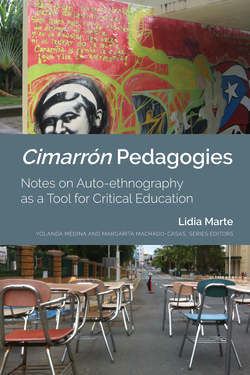Читать книгу Cimarrón Pedagogies - Lidia Marte - Страница 28
На сайте Литреса книга снята с продажи.
Introduction and Framings
ОглавлениеSimilarly of what I did in Chapter One, my intention is to use this more “academically informed” chapter, as a reference aid for readers to understand terms used in Chapter Three. In contrast to Chapter One, which is about Ethnography, this chapter is about Auto-ethnography; my focus in this chapter is to explain basic definitions and characteristics of auto-ethnography, with a brief tour of its emergence and development within and outside of anthropology, and its current status as an interdisciplinary methodology and narrative genre. I offer also my own definitions, based on the tailored version of critical auto-ethnography that I have been using in the classroom. In addition, I explain how I use auto-ethnographic projects to support a project-based, research-centered and place-based critical pedagogy practice. I conclude with a discussion of some theoretical framings (such as intersectional analysis, critical race theory, and ethno-semiotics) that are necessary to turn biographic data, from memoirs into auto-ethnographic critical cultural analysis that goes beyond the personal to the political.
←35 | 36→
The phrase “the personal is political” could be the most appropriate way to open this chapter on Auto-ethnography methodology, a research approach that places the researcher at the center of an investigation, and a writing style that openly uses the first person voice to report research findings. This now popular saying is usually associate with second wave feminist movements and publications of the 1970s; of uncertain origins, it is usually attributed to Carol Hanisch, due to her essay in 1970, in which she used it as a title, but the meaning implicated was discussed before and after by many other authors. Basically, it refers to how personal experiences (not only those of women) are shaped by the social locations that individuals occupy within systems of power relations. It foregrounds the significance of the social to understand the self, the collective to understand the individual, and vice versa, how the “public” is implicated in the “private,” and how all humans are social agents actively engaged within a matrix of power relations. As I say to my students, the private is so crowded, it is scandously public (as sodomy laws so clearly reveal), and public is always lived by particular subjects, from their individual locations (as an individual decision by a senator or a governor in office can reveal). Auto-ethnography is a methodology that allows us to map, concretely and symbolically, the personal roots and routes of a particular of how a particular topic (such as foodways or gendered identity) have unfolded in our lives, and the significance of that journey for our present experiences. In this sense it is centering the personal, the private self, to examine the public, the wider social contexts that have made possible an individual life. Because auto-ethnographic fieldwork research is done from wherever we are, it is always a form of “native” ethnography, this means it is done from our the local grounds of where we live, how we earn our living, our family and community networks, and place-making, the ways we navigate local place.
As the reader might already suspect, auto-ethnographic methodologies have been more easily embraced by interdisciplinary scholars of any field, that come from specific social locations, such as Indigenous, Africa-American, Latinx, Queer, functionally diverse scholars and other alter-native ethnographers entering the “fields” of academia as a profession. They (we) are the “others” who come from communities that used to be the usual objects of study of mainstream ethnographers. As part of these grouping of scholars, my understanding and evaluation of auto-ethnography are not meant to be authoritative. In a sense, these are my own auto-ethnographic (pun intended) interpretations shaped by the particularities of my academic training, my research and teaching praxis and my own cultural history. Many other possible stories of auto-ethnography can be traced from other perspectives (henceforth POVs), shaped as well by other authors’ own social locations and histories.
←36 | 37→
